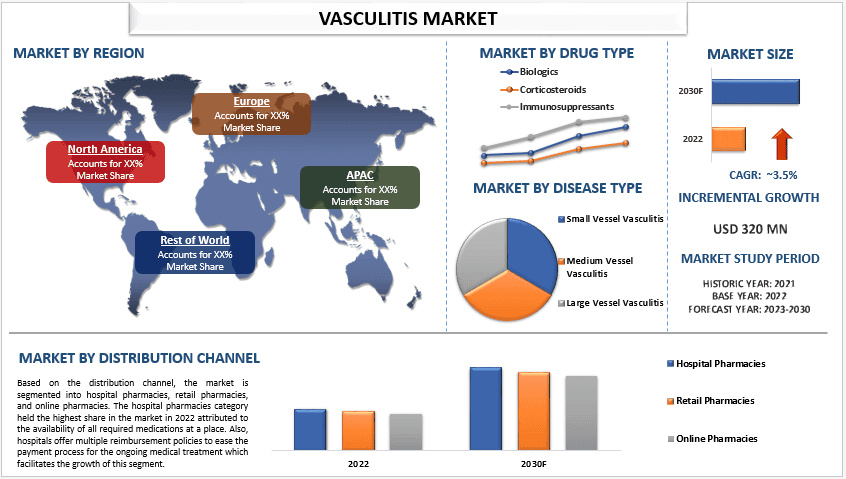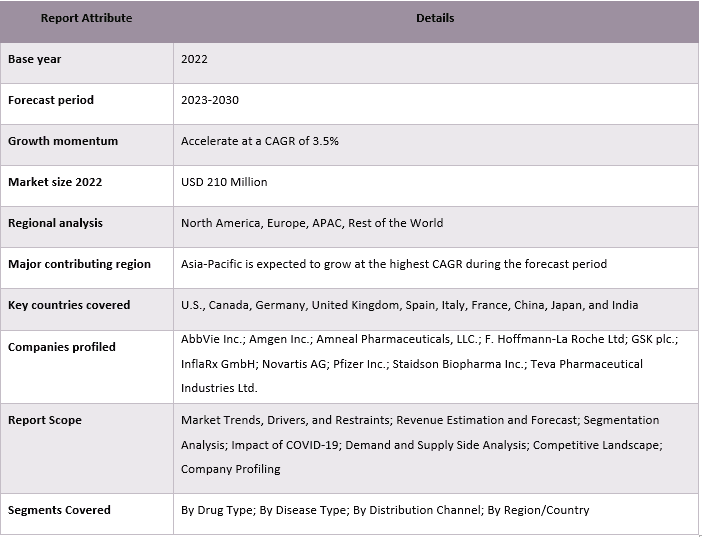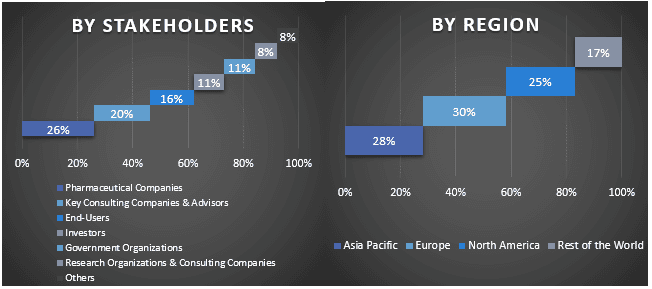- Home
- About Us
- Industry
- Services
- Reading
- Contact Us
Vasculitis Market: Current Analysis and Forecast (2023-2030)
Emphasis on Drug Type (Biologics, Corticosteroids, and Immunosuppressants); Disease Type (Small Vessel Vasculitis, Medium Vessel Vasculitis, and Large Vessel Vasculitis); Distribution Channel (Hospital Pharmacies, Retail Pharmacies, and Online Pharmacies); Region/Country

The Vasculitis Market was valued at USD 210 Million in 2022 and is expected to grow at a CAGR of 3.5% during the forecast period (2023-2030). owing to the surge in the incidence of vasculitis globally. Also, rising research and development activities aid in vasculitis, rising obesity among people, and the rising geriatric population globally. According to the World Health Organization (WHO), in 2020, there were 39 million overweight and obese children under five years of age. In addition to this, the increasing clinical trials by pharmaceutical companies to find a cure for vasculitis are also driving the vasculitis market. For instance, the French Vasculitis Study Group initiated the FAMILYVASC study which is a prospective observational study that aims to identify susceptibility loci and genes for systemic vasculitis risk in patients with familial or pediatric forms of vasculitis. This clinical trial is expected to be completed by the year 2029. Also, in July 2020, Hôpitaux de Paris started a clinical trial to perform a prospective longitudinal cohort study of vasculitis patients. Global pharmaceutical giants are leaving no stone unturned to showcase their potential.
Some of the major players operating in the market include AbbVie Inc.; Amgen Inc.; Amneal Pharmaceuticals, LLC.; F. Hoffmann-La Roche Ltd; GSK plc.; InflaRx GmbH; Novartis AG; Pfizer Inc.; Staidson Biopharma Inc.; Teva Pharmaceutical Industries Ltd.
Insights Presented in the Report
“Amongst drug type, the biologics category to grow with high CAGR during the forecast period”
Based on drug type, the market is segmented into biologics, corticosteroids, and immunosuppressants. The biologics segment is expected to grow with high CAGR during the forecast period owing to the associated side effects of other drugs including corticosteroids. Developed nations around the world like the U.S. and Europe have seen a surge in usage of these biologically extracted drugs. Also, rising research and development activities have led to the growth of this segment. For instance, Cambridge University Hospitals NHS Foundation Trust started a clinical trial in July 2021 to investigate three biologics, Infliximab, Rituximab, Tocilizumab, and placebos in the treatment of refractory non-ANCA-associated Vasculitis (NAAV) in adults and children. Thus, the biologics segment is expected to grow with a high CAGR during the forecast period.
“Amongst disease type, the large vessel vasculitis segment held a significant share in the year 2022”
Based on disease type, the market is segmented into small vessel vasculitis, medium vessel vasculitis, and large vessel vasculitis. The large vessel vasculitis segment held a significant share in 2022 majorly due to the rise increase in research and development activities and the increase in several immunocompromised patients globally. There are rising numbers of FDA approvals, clinical trials, and government investments that are driving this segment. For instance, the University of Edinburgh performed a clinical study on monitoring large vessel vasculitis with PET/MR imaging in January 2022. Thus, the large vessel vasculitis segment dominated the market in the year 2022 amongst modalities.
“Amongst distribution channels, the retail pharmacies segment to grow with a significant rate in the forecast period”
Based on the distribution channel, the market is segmented into hospital pharmacies, retail pharmacies, and online pharmacies. Retail pharmacies are expected to grow at a significant rate in the forecast period owing to better marketing strategies, relaxations in debt payments, and a wide network of distribution channels globally. For instance, In July 2023, CVS Pharmacy which is a U.S.-based retail pharmacy chain announced the launch of a program named, Caremark Cost Saver which aids in lowering pharmacy out-of-pocket drug costs for CVS Caremark clients’ members. Eligible members will have automatic access to good drug prescription pricing which will allow them to pay lower prices through this new program. Thus, the rising customer-friendly schemes and programs by retail pharmacies are driving the growth of this segment.
“Amongst regions, North America region held a significant share in the year 2022”
North America held a significant share of the market for vasculitis in 2022. Several factors such as the high capital investment, surge in research and development activities on finding novel drugs for treating vasculitis, increasing healthcare expenditure, increasing geriatric population, and rising patient awareness are driving the regional market. For instance, according to the report of the U.S. Census Bureau in 2021, more than 54 million people of geriatric age were living in the country in 2020 and this number is expected to reach 85.7 million by 2050, which will be about 20% of the total population of the U.S. Thus, North America dominated the vasculitis market among regions in the year 2022.
Vasculitis Market Report Coverage

Reasons to buy this report:
- The study includes market sizing and forecasting analysis validated by authenticated key industry experts.
- The report presents a quick review of overall industry performance at one glance.
- The report covers an in-depth analysis of prominent industry peers with a primary focus on key business financials, product portfolios, expansion strategies, and recent developments.
- Detailed examination of drivers, restraints, key trends, and opportunities prevailing in the industry.
- The study comprehensively covers the market across different segments.
- Deep dive regional level analysis of the industry.
Customization Options:
The global vasculitis market can further be customized as per the requirement or any other market segment. Besides this, UMI understands that you may have your own business needs, hence feel free to connect with us to get a report that completely suits your requirements.
Table of Content
Research Methodology for the Vasculitis Market Analysis (2023-2030)
Analyzing the historical market, estimating the current market, and forecasting the future market of the global vasculitis market were the three major steps undertaken to create and analyze the adoption of vasculitis in major regions globally. Exhaustive secondary research was conducted to collect the historical market numbers and estimate the current market size. Secondly, to validate these insights, numerous findings and assumptions were taken into consideration. Moreover, exhaustive primary interviews were also conducted, with industry experts across the value chain of the global vasculitis market. Post assumption and validation of market numbers through primary interviews, we employed a top-down/bottom-up approach to forecasting the complete market size. Thereafter, market breakdown and data triangulation methods were adopted to estimate and analyze the market size of segments and sub-segments of the industry pertains to. Detailed methodology is explained below:
Analysis of Historical Market Size
Step 1: In-Depth Study of Secondary Sources:
Detail secondary study was conducted to obtain the historical market size of the vasculitis market through company internal sources such as annual reports & financial statements, performance presentations, press releases, etc., and external sources including journals, news & articles, government publications, competitor publications, sector reports, third-party database, and other credible publications.
Step 2: Market Segmentation:
After obtaining the historical market size of the vasculitis market, we conducted a detailed secondary analysis to gather historical market insights and share for different segments and sub-segments for major regions. Major segments are included in the report as drug type, disease type, distribution channel, and region. Further country-level analyses were conducted to evaluate the overall adoption of testing models in that region.
Step 3: Factor Analysis:
After acquiring the historical market size of different segments and sub-segments, we conducted a detailed factor analysis to estimate the current market size of the vasculitis market. Further, we conducted factor analysis using dependent and independent variables such as drug type, disease type, distribution channel, and region of the vasculitis market. A thorough analysis was conducted for demand and supply-side scenarios considering top partnerships, mergers and acquisitions, business expansion, and product launches in the vasculitis market sector across the globe.
Current Market Size Estimate & Forecast
Current Market Sizing: Based on actionable insights from the above 3 steps, we arrived at the current market size, key players in the global vasculitis market, and market shares of the segments. All the required percentage shares split, and market breakdowns were determined using the above-mentioned secondary approach and were verified through primary interviews.
Estimation & Forecasting: For market estimation and forecast, weights were assigned to different factors including drivers & trends, restraints, and opportunities available for the stakeholders. After analyzing these factors, relevant forecasting techniques i.e., the top-down/bottom-up approach were applied to arrive at the market forecast for 2030 for different segments and sub-segments across the major markets globally. The research methodology adopted to estimate the market size encompasses:
- The industry’s market size, in terms of revenue (USD) and the adoption rate of the vasculitis market across the major markets domestically
- All percentage shares, splits, and breakdowns of market segments and sub-segments
- Key players in the global vasculitis market in terms of products offered. Also, the growth strategies adopted by these players to compete in the fast-growing market
Market Size and Share Validation
Primary Research: In-depth interviews were conducted with the Key Opinion Leaders (KOLs) including Top Level Executives (CXO/VPs, Sales Head, Marketing Head, Operational Head, Regional Head, Country Head, etc.) across major regions. Primary research findings were then summarized, and statistical analysis was performed to prove the stated hypothesis. Inputs from primary research were consolidated with secondary findings, hence turning information into actionable insights.
Split of Primary Participants in Different Regions

Market Engineering
The data triangulation technique was employed to complete the overall market estimation and to arrive at precise statistical numbers for each segment and sub-segment of the global vasculitis market. data was split into several segments & sub-segments post studying various parameters and trends in the areas of the drug type, disease type, distribution channel, and region in the global vasculitis market.
The main objective of the Global Vasculitis Market Study
The current & future market trends of the global vasculitis market were pinpointed in the study. Investors can gain strategic insights to base their discretion for investments on the qualitative and quantitative analysis performed in the study. Current and future market trends determined the overall attractiveness of the market at a regional level, providing a platform for the industrial participant to exploit the untapped market to benefit from a first-mover advantage. Other quantitative goals of the studies include:
- Analyze the current and forecast market size of the vasculitis market in terms of value (USD). Also, analyze the current and forecast market size of different segments and sub-segments
- Segments in the study include areas of drug type, disease type, distribution channel, and region
- Define and analyze the regulatory framework for the vasculitis industry
- Analyze the value chain involved with the presence of various intermediaries, along with analyzing customer and competitor behaviors of the industry
- Analyze the current and forecast market size of the vasculitis market for the major region
- Major countries of regions studied in the report include Asia Pacific, Europe, North America, and the Rest of the World
- Company profiles of the vasculitis market and the growth strategies adopted by the market players to sustain in the fast-growing market
- Deep dive regional level analysis of the industry
Frequently Asked Questions FAQs
Q1: What is the current market size and growth potential of the vasculitis market?
Q2: What are the driving factors for the growth of the vasculitis market?
Q3: Which segment has the largest share of the vasculitis market by drug type?
Q4: What are the emerging technologies and trends in the vasculitis market?
Q5: Which region will dominate the vasculitis market?
Q6: Who are the key players operating in the vasculitis market?
Related Reports
Customers who bought this item also bought










